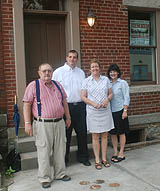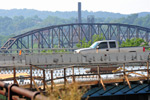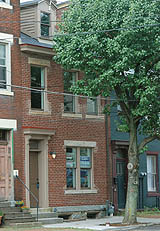
Category Archive: Easements
-
New Hope for Jeannette Glass Co. Plant Site
Thursday, July 29, 2010By Candy Woodall – Pittsburgh Post-GazetteRobert Carter drives past it every day. He sees the blemish on the city landscape and questions the fate of the old Jeannette Glass plant.
A city firefighter for the past 36 years and the mayor for the past six months, Mr. Carter is quite familiar with Jeannette Glass Co.
“I remember when it was booming,” he said.
He remembers when the plant got so busy churning out coffee cups and bowls that the fire department had to go there to cool the tanks.
He remembers when it closed in 1983.
And he remembers getting a call to put out flames when a fire ravaged the plant for 22 hours in the mid-1980s.
Even though he still wears a fire helmet, it’s the hat he wears as mayor that is causing him to put out flames of a different kind these days.
In a 3-2 vote, city council last week approved a trip to New York City, during which Mr. Carter and solicitor Scott Avolio will try to calm a decades-long dispute between Abraham Zion and officials throughout Westmoreland County.
Mr. Zion bought the Jeannette glass plant for $4 million in 1983. Since then, local leaders have engaged with him in a number of fits and starts, hoping to do something with the old facility that is now falling apart. It has been exposed to the elements and is “a total eyesore,” according to the mayor.
John Skiavo, president of nonprofit Economic Growth Connection of Westmoreland County, said officials got close a few times, but talks ultimately went nowhere. He last communicated with Mr. Zion in 2007, he said.
“We had meetings for five years straight, but in the end, [Mr. Zion] was never agreeable,” he said.
Mr. Zion, 85, was not available for comment. An assistant in his New York office said he has a medical condition and doctors appointments.
That medical condition is why Mr. Carter is traveling to him.
The mayor said Mr. Zion first reached out to him six months ago with a phone call to congratulate him on his election.
“Out of nowhere, I got a call. It knocked me off my heels a little. He definitely caught my attention,” Mr. Carter said.
Mr. Zion told him he wanted to do something with the property, and Mr. Carter saw it as a breakthrough.
“It’s been a long time coming, and I don’t want to miss the opportunity to get that property cleaned up,” he said.
No specific plans are in place for their visit, but Mr. Carter said he hopes to go “within the next month, as soon as possible.”
The property sits in the heart of the city like a monument, with rusted remnants reminding passers-by what Jeannette was in its heyday. It sits on about 32 acres on two parcels between Chambers and Bullitt avenues facing Sixth Street, with an appearance starkly different from the development going up around it.
As part of a $31 million effort to revamp the city, 25 single-family homes and a nine-unit townhouse complex have been built along South Sixth Street.
“There’s a major project in front of [the glass plant],” Mr. Carter said. “When people look out their back doors, they see an old, rundown industrial yard. And I don’t want people to think this is some old, rundown community.”
Getting the property cleaned up is his first priority.
“I’m not going to New York with stars in my eyes. I’m going on a mission,” he said.
The mayor and Councilman Jeff DePalma, who voted in favor of the trip, noted that Mr. Zion has been a good taxpayer, doling out $68,000 a year in property taxes — more than $1 million in the past 20-plus years — and can only hope he will be as diligent with the actual property.
“I honestly can’t read his mind. [Mr. Zion] has just never seemed totally determined to do anything with the property,” said Mr. Skiavo, of Economic Growth Connection. “That property is a real nuisance for the city and can become a real detriment as it further deteriorates.”
Three years ago, Mr. Skiavo and colleagues, through their redevelopment organizations, offered to buy the property for about $500,000 and clean it up, which would have cost “hundreds of thousands of dollars,” he said. Mr. Zion would have been relieved of all liability and able to sell the scraps.
“He entertained the possibility, but turned us down,” Mr. Skiavo said.
In 2007, Mr. Skiavo wrote a report to city council, saying the only avenue left was to force Mr. Zion to clean up the property through enforced ordinances and codes.
The history of failed business relations with Mr. Zion is why councilmen Mike Clark and Ron Dinsmore voted against the trip to New York.
Mr. Carter said he’s aware of the history, but has to try.
“I have a lot of naysayers, but I can’t live in the past. I can’t change yesterday.
“That property has just sat there for years and years and years. This is an opportunity to change that.”
Mr. Skiavo said the property could probably house a commercial or light manufacturing facility.
Mr. Carter drives past the dilapidated plant and envisions green space, a park setting, small specialty shops, something to promote the city rather than put a damper on it.
“One way or another, when that meeting is over, I will have a defined answer about what is going on with that property,” he said.
-
Buying Here: Deutschtown
Saturday, July 17, 2010By Kevin Kirkland, Pittsburgh Post-GazetteEven by North Side standards, 621 Tripoli St. was a challenge.
The original 1890s brick townhouse was intact, but the later wood-frame addition on the back was crumbling and falling away, and raccoons had made themselves at home. Worst of all to an old-house lover, someone had cut into the front facade and installed a picture window, probably in the 1970s.

Members of the Northside Leadership Conference, from left, are Bernard Beck, president of East Allegheny Community Council; Greg Jones; Nancy Noszka, director of real estate for the Northside Leadership Conference; and Teekie Smith, Coldwell-Banker agent. Larry Roberts/Post-Gazette
The window is history now, as is the early 20th-century addition, replaced by a new wood-frame rear section containing the kitchen, part of the dining room and a second-floor bedroom. The two-bedroom, 11/2-bath house is on the market for $219,900 through Teekie Smith of Coldwell Banker Real Estate’s Shadyside office (412-708-1588 or www.pittsburghmoves.com, MLS No. 826966).
Ms. Smith says the house is a perfect blend of old character and new amenities.
 Deutschtown:
Deutschtown:
At a glance- Website: www.deutschtown.org
- Size: .236 square miles
- Population: 2,635 (2000 census)
- School district: Pittsburgh Public, www.pghboe.net
- Enrollment: about 28,000
- Average SAT scores: 358 verbal; 383 math; 362 writing (2009, Oliver High School)
- Taxes for a house assessed at $100,000: $2,941; County: $469 (4.69 mills); City: $1,080 (10.8 mills); School: $1,392 (13.92 mills)
- Wage tax: 3 percent (1 percent to the city, and 2 percent to the school district)
- A bit of history: Deutschtown — also known as East Allegheny and Dutchtown — dates back to the mid-1800s and grew as the City of Allegheny expanded eastward. As its name implies, it was once the heart of Pittsburgh’s German-speaking community. It is still headquarters for the 150-year-old Teutonia Maennerchor, the largest German singing society and social club in the region. The neighborhood was added to the National Register of Historic Places in 1983.
“The developers have tried their hardest to preserve anything original,” she said. “The hardware is wonderful. There are locks and latches that I’ve never seen before. But it’s also got new floors, air conditioning, a second-floor laundry, off-street parking [two spaces] and a big backyard.”
This is the fifth project in the past 10-15 years involving the Northside Leadership Conference and East Allegheny Community Council, says Greg Jones, project manager for the Northside Leadership Conference. Al Depasquale and October Development were the general contractors on this renovation and another at 517 Tripoli. Mr. Depasquale is also the developer and contractor on three new houses going up around the corner on James Street.
In late 2008 and early 2009, October Development finished building three new brick houses and renovating two old ones in the 900 block of James. The three new townhouses sold for $229,000 each and the old ones for $190,000 and $165,000, respectively.
“The new ones sold before construction,” Mr. Jones noted. “The speed and price were unprecedented in this area.”
This part of the North Side is usually called East Allegheny or Historic Deutschtown in recognition of its large German population in the late 19th century. It was divided by construction of the Parkway North in the 1980s. Many century-old brick townhouses remain, along with more modest wood-frame dwellings. Some have been renovated, but not as many as in nearby Allegheny West and the Mexican War Streets, where houses are generally more expensive.
Mr. Jones said buyers are fairly evenly divided between young professionals and older empty-nesters, many of whom are familiar with the North Side and its historic yet affordable housing stock.
“They say, ‘My friend bought one in this neighborhood.’ It’s a limited supply but a heck of a market. They often sell by word of mouth,” he said.
“These people have an interest in historic restoration. They know what they’re getting into. They get a house with some character that has a story to it.”
Adding to the attraction is a 10-year abatement on city and school property taxes and a three-year abatement on county taxes that can save buyers as much as $30,000 to $40,000, he said. Depending upon income, they may also qualify for a second, deferred mortgage, Ms. Smith said.
The home at 621 Tripoli is unusual in that it was renovated with no public subsidy through funding from the Northside Community Development Fund. The design/build process used reduced the need for an architect and sped construction. Luckily, many of the old doors and much of the hardware and trim were reusable, as was the original staircase and mantels on the two decorative fireplaces. Preservation expert Nick Kyriazi, a longtime member of the East Allegheny Community Council, even came up with old lighting fixtures for the first floor.
“They were restored and rewired. They’re stunning,” Ms. Smith said.
Although the front parlor and floor plan were retained, the new rear section is very open, with granite countertops in the new 13-by-13-foot kitchen. The new powder room is tucked away nearby, and the large modern bathroom upstairs serves bedrooms measuring 17 by 15 feet and 17 by 13 feet, respectively, each with large closets. The developers opted to make the third floor a storage area rather than living space (the ceiling height is only about 6 feet).
The East Allegheny Community Council bought the property for $9,900 in June 2008, and its assessed market value is $9,000 (www2.county.allegheny.pa.us). Five properties have sold on Tripoli in the past three years for prices ranging from $17,500 in July 2009 to $215,000 in September 2009 for the October Development rehab at 517 Tripoli. One property sold twice (www.realstats.net).
This house is three blocks away from Allegheny General Hospital and Allegheny Commons Park and 5-10 minutes waking distance from Downtown, Heinz Field and PNC Park. An open house will be held from 1 to 4 p.m. this Sunday and next Sunday.
-
170-Year-Old Tavern in Menallen to Serve Up the Past
By Mary Pickels
TRIBUNE-REVIEW
Thursday, July 22, 2010
Fayette County Historical Society President Jeremy Burnworth is in the restored main room on the second floor of the former Abel Colley Tavern, which will is the society's headquarters. Barry Reeger | Tribune-Review
The Fayette County Historical Society Friday will hold a grand opening of its museum, to be housed in the former Abel Colley Tavern in Menallen.
Open to the public, the 3 p.m. program will showcase the restored red-brick structure at 7083 National Pike.
Last July, Warren and Virginia Dick of Smithfield donated the 170-year-old building to the historical society. Volunteers helped to restore the property, which is listed on the National Register of Historic Places.
Society President Jeremy Burnworth credited volunteer Tom Buckelew and former intern Bill Zinn, along with inmates from the State Correctional Institution at Greene, who performed labor through the Community Works Program, for much of the renovation.
Community volunteers pitched in to paint walls, install moulding and restore hardwood floors.
Although some work remains, the majority of the main rooms have been restored, Burnworth said.
Photos to be displayed Friday will show the “before” and “after,” he said. “You will be able to see (the volunteers’) accomplishments in a short amount of time. We want to let people see the beautiful work that has been done.”
Additional work will help take the structure to its next level, becoming a museum, Burnworth said.
“It’s Fayette County’s first-ever historical museum,” he said. “It’s kind of a big deal.”
Friday’s program will include local government officials, Dick family members and representatives from the National Road Heritage Corridor and the Sen. John Heinz History Center. The historical society is an affiliate of the history center and may benefit in the future through a display of Civil War memorabilia, Burnworth said.
In the future, the site will be used for the society’s headquarters. It will be available for fundraisers and meetings.
Donations of historical artifacts pertaining to Fayette County are welcome.
“They can go way back, 50 to 250 years old,” Burnworth said. “For example, think of veterans.”
There has been no place in the county to display photos, uniforms, letters or furniture, he noted.
“We are afraid people will be throwing things away,” he said. “We really want a situation in place, so even if family members are not interested, we can protect and archive (those items). We get lots of calls for information, requests to come to the building and look at the archives and all of the things people think we have.”
Plans include a gift shop, likely to include publications and books on the region’s history. In acknowledgement of the building’s history, keepsake mugs will be sold on Friday.
Public visitation hours have not been set.
“The committee will help determine the direction of ‘what’s next,'” Burnworth said.
For more information, or to donate or volunteer, visit the society’s website at www.fayettehistory.org. Anyone interested in attending Friday’s opening or joining an advisory committee is asked to call 724-439-4422.
-
Firms Pitch Building Plans for Garden Theater Area
By Bill Vidonic
PITTSBURGH TRIBUNE-REVIEW
Tuesday, July 20, 2010The owner of a central North Side business only wanted to hear one issue addressed Monday about the redevelopment of the block surrounding the vacant Garden Theater.
“Parking, parking, parking,” said Irene Karavolos, co-owner of Steve’s New York Hot Dogs on Federal Street. “You can’t bring in more businesses when little businesses already are starving for parking.”
More than 200 people crowded into an auditorium at the Children’s Museum of Pittsburgh to hear several proposals for the block surrounding the former X-rated theater, with five developers promising to spend tens of millions of dollars to revitalize the blighted section of the North Side.
All submitted proposals calling for a mix of retail and residential development; two called for the partial or complete destruction of the vacant Garden Theater auditorium.
Kirk Burkley, president of Northside Tomorrow, which is coordinating redevelopment efforts, said the Garden wouldn’t vanish entirely under any of the proposals. City and national historical designations mean the building’s facade must be preserved.
“This project affects more than just the central North Side,” Burkley said.
North Side resident Matt Long said he’d like to see the Garden restored as an independent filmhouse.
“I don’t think retail would be what I’d put there,” Long said.
Tom Hardy, a consultant with Northside Tomorrow, said a decision could come in the next couple of months.
“We have some momentum now,” Hardy said. “There’s an interest in keeping that momentum going.”
North Side visionsDevelopment proposals for the Garden Theater block:
• Barron Commercial Real Estate, Pittsburgh: Demolish the former Garden Theater auditorium, but preserve and restore the remaining historic properties into a mix of housing and retail development.
• Wells and Company, Spokane, Wash.: Restore the Garden Theater auditorium for a performing arts center; build apartments in the former Masonic building, along with a first-floor restaurant/brew pub; and restore buildings along West North Avenue and Reddour Street.
• Zukin Development Corp., Philadelphia: Create retail space, including a specialty grocery store, by demolishing part of the Garden Theater; create retail space and apartments in the Masonic Hall, the Bradberry apartment building and other properties.
• Aaron Stubna and William Porco, Coraopolis: Convert the Garden into a multi-purpose theater hosting live entertainment and films.
• Resaca LLC, Pittsburgh: Redevelop the Bradberry into 16 one-bedroom apartments.
Source: Northside Tomorrow LLC
-
$17.5 Million for Steel Heritage Sought
dBy Matthew Santoni, PITTSBURGH TRIBUNE-REVIEW
Saturday, July 17, 2010
National heritage park promoters want a ramp built at the Rankin Bridge to provide better access to the former Carrie Furnace (background). Sidney Davis | Tribune-Review
Allegheny County officials are hoping the federal government will invest $17.5 million in a project to turn a former steelmaking site into a national heritage park and build a ramp at the Rankin Bridge to lead visitors to it.
The county, city of Pittsburgh, Port Authority and Port of Pittsburgh Commission are among agencies seeking a share of $600 million in transportation grants that would fund projects to reduce congestion, promote economic activity or improve livability.
At Carrie Furnace, the county wants to build a “flyover” ramp from the interchange at the foot of the Rankin Bridge to carry traffic above four railroad tracks that isolated the former steel mill.
“The (current) access is good for emergency vehicles and some other traffic, but it’s over two sets of active railroad tracks, and you’d have to wind your way back there on a couple of little, local streets,” said Bob Hurley, deputy director of the county’s Department of Economic Development.
The county wants to redevelop 148 acres that once housed the blast furnaces along the Monongahela River in Rankin, part of the former U.S. Steel Homestead Works. The project would include homes, offices and light industry, along with a park commemorating the Mon Valley’s industrial heritage, Hurley said.
The Homestead-based Rivers of Steel National Heritage Area, which took over the furnaces, wants to offer public tours of the site to drum up support for a museum, said Sherris Moreira, director of marketing and tourism development. Built in 1907 of steel plate and brick, the Carrie Furnaces No. 6 and 7 tower 92 feet above the river as examples of pre-World War II iron-making technology. They are the only non-operative blast furnaces remaining in Pittsburgh. In the 1950s and ’60s, they produced up to 1,250 tons of iron a day.
The county tried to get stimulus money for the project and did not; that application asked for $60 million and included a plan to convert an old bridge over the Mon for cars and pedestrians going to Route 837 and The Waterfront. Officials will still try to get money for the bridge, Hurley said.
The $600 million in transportation grants will be awarded in fall. Others seeking money:
• Port of Pittsburgh Commission, as a government partner for river industries. Cecil-based Consol Energy Inc. wants $44 million to add a coal storage area to its Alicia Docks near Brownsville, and Three Rivers Marine and Rail Terminal near Charleroi wants $1.5 million to upgrade railroad connections. The companies would invest matching money.
• The Port Authority of Allegheny County might reapply for money to start its “Better Bus” or “Rapid Bus” initiative, said spokesman Jim Ritchie. The authority plans to convert nine routes to “rapid bus” service that would have fewer stops, use ticket machines at bus stops instead of fare boxes on buses and get priority at traffic signals in order to make faster trips to Pittsburgh International Airport, Downtown, Oakland, the East End and the Mon Valley.
-
McKeesport Will Demolish 15 Homes
Thursday, July 15, 2010By Candy WoodallMcKeesport’s 7th Ward is getting a face-lift.
Despite a poor economy, McKeesport continues to attract stimulus dollars to improve its neighborhoods.
Using a $100,00 from Allegheny County, Mayor James Brewster said the city will raze another 15 blighted homes along Bailey Avenue, beginning on July 27.
“We’re tearing down a house every four days,” he said.
Mr. Brewster has worked to remove half of McKeesport’s 600 blighted properties since he took office seven years ago, calling them fire and public safety hazards.
Old, boarded-up houses aren’t the only things coming down in the 7th Ward.
Cornell Intermediate School is being demolished to make way for the new Cornell Elementary/Intermediate School being built on the same property as part of McKeesport Area School District’s $46.4 million plan to build two new schools and renovate a third.
The Cornell construction will cost $29 million and help revitalize the neighborhood, according to Superintendent Michael Brinkos.
It is being developed as a green building that will accommodate kindergarten through sixth grade, featuring state-of-the-art facilities and technology, he said.
A public hearing was held Monday in the district’s board room regarding the school’s construction plans.
In addition to removing blight and replacing a 94-year-old school with a new one, City Council also unanimously approved an agreement with McKeesport Neighborhood Initiative to begin $1.4 million of housing development in the Seventh Ward.
“That will complement the new Cornell school,” Mr. Brewster said.
A Weed & Seed initiative will offer help in the 7th Ward, which is a target area along with the 2nd, 3rd and 5th wards.
As a local branch snags funds from Pennsylvania’s recently passed budget, it will work to fulfill the goals of Weed & Seed, a national program that seeks to improve conditions in high-crime neighborhoods.
The city’s Weed & Seed will have $75,000 from the state and $8,330 from the city for an $83,330 budget for the coming year, said Dennis Pittman, city administrator.
The money is earmarked for prevention and intervention programs and pairs with law enforcement efforts.
-
Group Asks 1-Year Delay in Mellon Arena Demolition
Thursday, July 15, 2010By Mark Belko, Pittsburgh Post-GazetteA group seeking to save Mellon Arena today urged its owner to delay a proposed demolition for one year.
Rob Pfaffmann, a Downtown architect who leads Reuse the Igloo, asked the city-Allegheny County Sports & Exhibition Authority board to give the group a year to develop an economically viable plan to save the Igloo. The SEA owns the building.
“We do not want to see a white elephant,” he said.
Mr. Pfaffmann said the group also would develop a plan to help the SEA cover the operating costs of the building while a more thorough planning process is undertaken and alternatives are studied.
“We should not rush to judgment on this if we have an economic circumstance that doesn’t demand it,” he said.
Mr. Pfaffmann was among about 10 people to speak at the SEA meeting today in favor of saving the building.
“There’s no do over. Once it’s gone, it’s gone and it will never be back again,” said Nancy Motz Cosnotti. “If the Civic Arena is gone, then part of Pittsburgh will be gone and I don’t want that.”
Reuse the Igloo also would like to see the SEA open the arena’s distinctive dome as a demonstration to see if it still works and to determine the cost of operating it.
SEA Executive Director Mary Conturo said no vote has been scheduled yet on a demolition, favored by the Penguins, Mayor Luke Ravenstahl and county Executive Dan Onorato.
She said the SEA is still in the process of reviewing options through an ongoing historic review process.
Asked whether the SEA would agree to a one-year delay, board chairman Wayne Fontana said the request would be taken under advisement.
“I’m not adverse to anything at this point,” he said.
-
Could New Teams Save Old Mellon Arena?
Wednesday, July 14, 2010By Mark Belko, Pittsburgh Post-GazetteFor some, it’s a pipe dream. For Aubrey Bruce, it’s a mission.
A former music promoter, Mr. Bruce hopes to save Mellon Arena by recruiting an arena football team, a Women’s National Basketball Association team and an American Basketball Association team to play there.
It’s debatable which is the biggest challenge.
Still, Mr. Bruce, who writes sports columns for the New Pittsburgh Courier, has formed Seastorm Sports Management Group with hopes of salvaging Mellon Arena by recruiting teams to play under its iconic silver dome.
“We understand that it is going to be a hard road to climb,” he acknowledged.
Mr. Bruce has talked to Rob Pfaffmann, the Downtown architect who is leading the effort to save the Igloo about his ideas. He also plans to make a presentation to the city-Allegheny County Sports & Exhibition Authority as part of the historic review process, but has yet to do so. He said his main objective is to rescue Mellon Arena, which was slated for demolition as part of a plan by the Penguins to redevelop the property with offices, residences and commercial ventures.
“Our goal is to save the Civic Arena,” he said. “It’s symbolic of Pittsburgh shedding its industrial skin and moving into the electronic age. It’s a very important symbol, I think, of Pittsburgh.”
Mr. Bruce has had some preliminary contact with the Arena Football League about his idea, but has yet to talk to Commissioner Jerry Kurz or an owner or prospective owner with any interest in placing a team in Pittsburgh.
However, Mr. Kurz, at a news conference in February, did say that the 15-team reconstituted league, under new leadership after folding last year, had an interest in expanding into Pittsburgh and several other cities by 2011.
Linnea Coulter, manager of media services for the Arena Football League, said she had talked to Mr. Bruce about a month and a half ago and forwarded his information to Mr. Kurz. She said she has not heard anything since then.
Mr. Bruce has had no formal contact with the WNBA, but said he had spoken with a marketing representative with the affiliated National Basketball Association. He said he also had talked to Joe Newman, the American Basketball Association CEO. The ABA currently has a team in Pittsburgh, the Phantoms, which played at Carnegie Library in Homestead last season.
Neither Mr. Newman nor Ron Howard, director of WNBA communications, could be reached for comment.
While Mr. Bruce readily acknowledges that he has yet to get anything close to a commitment from any of the leagues, he believes teams would be interested in playing in a redesigned Mellon Arena with seating for 5,000 to 6,000 people.
He is hoping the SEA, which owns the old building, will issue a moratorium that would prevent any demolition for at least a year.
There are big obstacles, however. Unclear is who would pay the millions of dollars to renovate Mellon Arena or foot the bill for the costs of operating and maintaining it. The SEA has estimated that insurance and utility costs alone could run as much as $100,000 a month. Mr. Bruce believes rent from the teams would pay part of it.
The former promoter also may have to battle the Penguins ownership, which isn’t keen about the idea of keeping two arenas side by side. And an arena football team could fill open dates at the new arena.
Penguins President David Morehouse said Tuesday that revenues from arena football and WNBA and ABA basketball would not pay for the cost of redoing and maintaining the arena.
“If an arena football team came to Pittsburgh, they would want to play in the brand new Consol Energy Center,” he said.
Mr. Morehouse also questioned the viability of plans floated in an effort to save Mellon Arena. “There are all kind of cockamamy ideas out there. The question is: Does anyone have anything that’s financially viable?” he asked.


